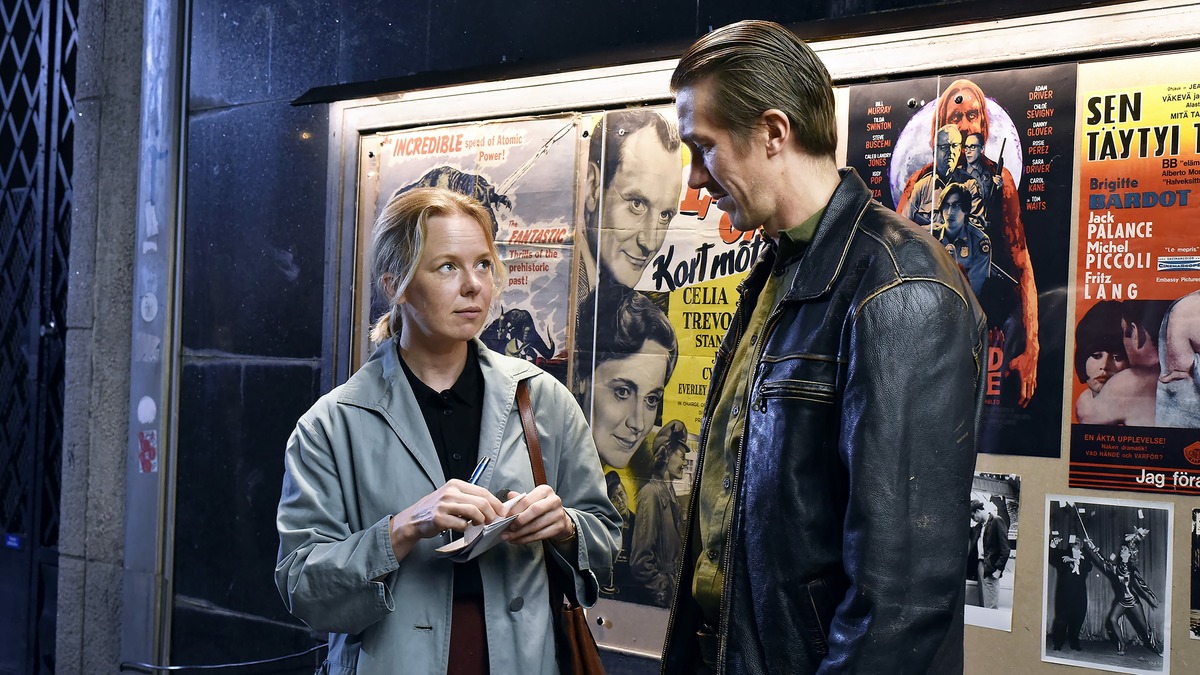Welcome to our Colossus Movie Guide for Fallen Leaves. This guide contains our detailed library of content covering key aspects of the movie’s plot, ending, meaning, and more. We encourage your comments to help us create the best possible guide. Thank you!
What is Fallen Leaves about?
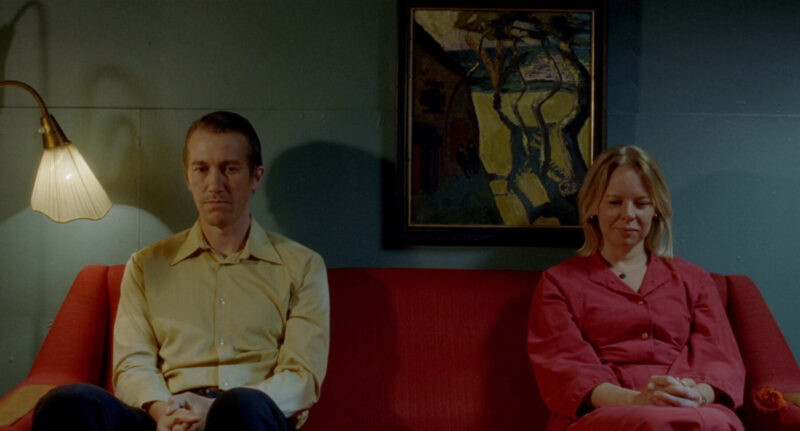
Fallen Leaves is, above all else, a romance about how to combat the crippling reality of loneliness that plagues so many. The movie digs deep into how we deal with being alone and push through tough times, and captures the intense drive to forge bonds that matter in an often cold world. Through Ansa and Holappa’s eyes, we’re confronted with a vivid image of life frayed by economic woes, overshadowed by the cold shoulder of society, overwhelmed by the inescapability of apocalyptic war. As these two broken people inch toward one another, their actions echo our collective quest for romance and connection as we wade through personal demons, through political disarray. Director Aki Kaurismäki’s frequent nods to classic and contemporary cinema pronounces art’s ability to mirror our lives and showcase the human spirit’s undying and unwavering resilience. Despite the meeting of outside chaos and inside trouble, an overwhelming confrontation of the macro and micro that affects everyday life, there’s can still a chance for kinship. Ansa and Holappa’s understanding of this powerful truth shows that meaningful connections can save us in the most dire of moments.
Movie Guide table of contents
Cast
- Alma Pöysti – Ansa
- Jussi Vatanen – Holappa
- Janne Hyytiäinen – Huotari
- Nuppu Koivu – Liisa
- Aki Kaurismäki – Writer, director
The ending of Fallen Leaves explained
A recap of Fallen Leaves‘ ending
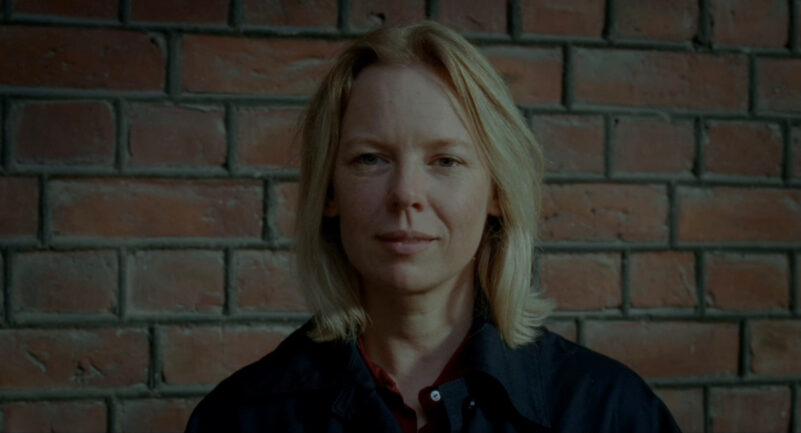
Holappa, once entangled in the grips of alcohol and shaky employment, takes a firm stand to fix his life by ditching the booze. By kicking alcohol to the curb, Holappa signals a major shift in his life’s trajectory, firmly committing to better days ahead and potentially a shared path with Ansa.
But in a dramatic twist, Holappa is struck by a train on his way to meet Ansa. As Holappa lay comatose, Ansa’s daily hospital visits display her deepening feelings and steadfast devotion to a man she barely knows—but a man who’s willing to change for her. She sits by his side and reads news reports, and even makes up sensational stories she believes will jolt him awake.
At the end, Holappa wakes up from his coma and him and Ansa leave the hospital in a moment that specifically pays homage to a classic movie (more on that in a second). The movie doesn’t tell you exactly what happens after, but there’s hope they can help each other find solace in this irrational world.
Modern Times, the dehumanizing nature of capitalism, and the timeless power of art
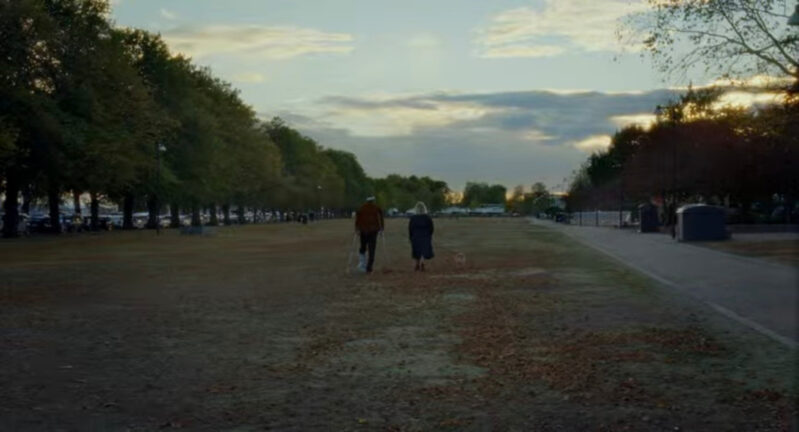
Many people may not realize it, but the final shot of the film is a direct homage to Charlie Chaplin’s film Modern Times. This reference brings conclusion to two of the movie’s most important themes: the crushing nature of a capitalistic world and the importance of art in our lives. Thus, these final moments bring closure to Ansa and Holappa’s shared tale as they seek to build something new from the rubble of their broken lives.
Focus #1: Capitalism
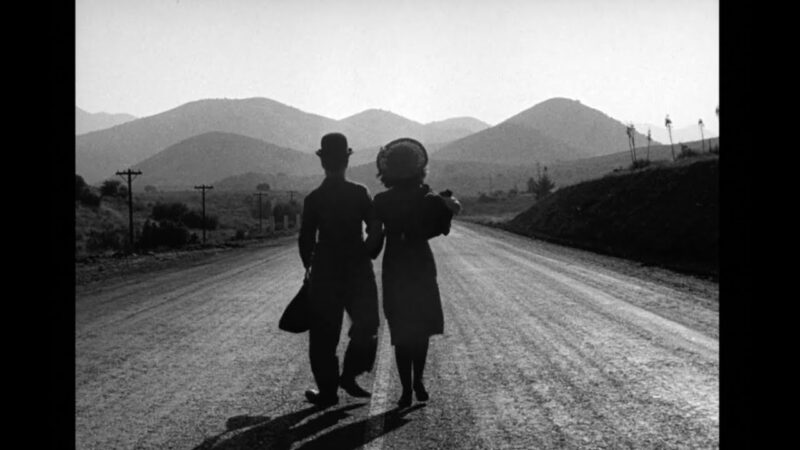
Through Chaplin’s classic character The Tramp, Modern Times notably captures the commoner’s plight, railing against a soulless industrial behemoth that treats people as mere cogs in its vast machine. The timeless film examines the difficulties faced by everyday people in an increasingly mechanized world (very similar to what Eraserhead does as well), touching on themes of exploitation and dehumanization within a modern capitalist system. By invoking this work, Kaurismäki calls attention to comparable ideas in Fallen Leaves: the struggles of the working class, the challenges of economic instability, and the pursuit of happiness in an often indifferent world.
Caught in the relentless grind of factory life, the Tramp’s gradual physical and mental breakdown vividly captures the soul-crushing impact of industrialization. Throughout the film, Charlie Chaplin’s character bounces from gig to gig, embodying roles like a watchman and crooning server but never stays put long—each job ends in a blend of humor and mishap. Along the way, the Tramp is accompanied by a young, orphaned woman named Ellen (played by Paulette Goddard), who is also striving to survive in the harsh economic climate. United in adversity, they carve out a small niche for themselves, clinging to each other as society turns its back on them. This is very similar to what repeatedly happens to Holappa and Ansa in Fallen Leaves.
The ending of Modern Times is famously open-ended and optimistic. After a series of failed endeavors and run-ins with the law, the Tramp and the young woman find themselves walking down a desolate road. Undeterred by the setbacks they’ve weathered, they stride into an uncertain horizon, the Tramp’s silent encouragement a testament to their unwavering hope and tenacity. The film’s close doesn’t neatly tie up all loose ends, opting instead to embody a relentless sense of hope and grit amid ongoing adversity.
The characters of Modern Times are analogous to the characters of Fallen Leaves in how they personify the unwavering spirit of those grappling with economic strife. The Tramp character, with his enduring optimism, reflects a similar spirit to Holappa’s journey from despair to a semblance of hope, while Ansa stands strong much like Ellen, both of them firmly rooted in a gritty reality that tests their resilience. The two women push their partners to keep trying even when things look hopeless.
This theme is further expanded by the war between Russia and Ukraine, which is largely driven by money and power. The constant radio reports of people dying at the hands of a selfless, greedy war puts a mental strain on both Ansa and Holappa, who are struggling enough as it is. Between the war and the nature of capitalism, Fallen Leaves selectively paints a world that churns at an exhaustingly and uncontrollably cruel pace. Ansa and Holappa’s gradual journey, while marked by challenges, ultimately ends with them finding in each other a comforting sanctuary that transcends the suffocating stranglehold capitalism and war places on people trying to balance hard, low-paying labor, mental well-being, and optimism for the future.
Focus #2: Art and movies
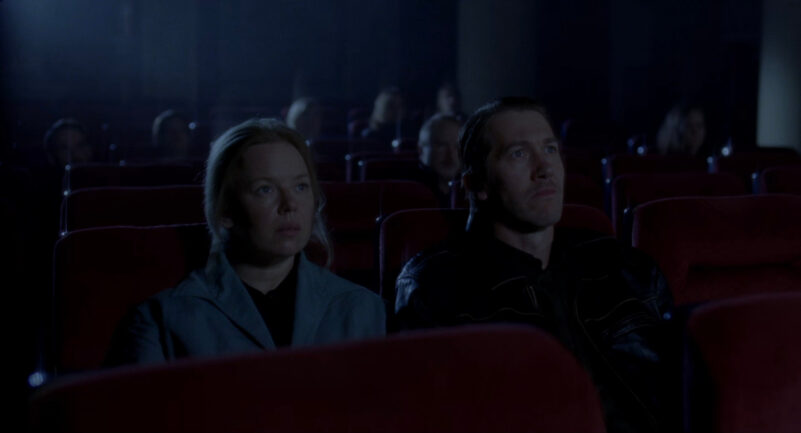
The most beautiful moments in Fallen Leaves come through the plethora of movie references—a deliberate choice by director Aki Kaurismäki that serves to underscore the powerful role cinema, and all art for that matter, plays in shaping and echoing our experiences. These movie references are not just random nods to film history, but show how art copies life, giving us both an escape and a deeper grasp of being human. Altogether, these movies become the backdrop to Ansa and Holappa’s lives, hinting their problems are not just personal but part of the broader human story.
Movies, and all art, for that matter, from music to paintings to books, capture our life stories, showing us reflections of ourselves and giving depth to the way we see the world. Films like Brief Encounter, Diary of a Country Priest, and Pierrot le Fou, which are all referenced in Fallen Leaves, encapsulate a range of human emotions and situations, from romantic longing to existential angst. You could argue that each and every movie referenced in this film (If you’d like a full list of them all and the potential thematic significance of each, then check our questions and answer section) serves to comment on our ability to engage with art in a more meaningful way. When we give ourselves over to the stories of movies, we allow our stories, no matter how inconsequential and hopeless they may seem, to be immortalized.
Ansa and Holappa’s shared experience of watching Jim Jarmusch’s film The Dead Don’t Die on their first date in Helsinki is a significant moment that sets this theme in motion. This contemporary film, known for its deadpan comedy and reflection on modern existence, creates a shared space for our two main characters, a common ground where they can connect. Ansa’s comment that she’s “never laughed so hard” is a comical nod to the shared dry nature between Jarmusch’s film and Kaurismäki’s film, indicating that life and art often blend together in the most obscure yet relieving of ways. Their date serves as a moment where they find solace in a shared appreciation for storytelling that mirrors their own lives. The movie’s themes of survival and coping with absurdity resonate with their personal struggles, forging a deeper bond between them without that truth needing to be spoken aloud.
Which makes the ending homage to Modern Times such a triumphant step forward for Ansa and Holappa. In a way, this is Kaurismäki himself stepping into frame, saying that the story of Ansa of Holappa, a narrative that resonates with so many modern people who feel overwhelmed and abandoned by capitalism and war, in a moment where the leaves have died and fallen and the cold reality of winter is on its way, was a struggle back when Chaplin made Modern Times as well. It shows the unquestionable power of art to comment on life’s struggles and to provide direction in moments of despondency, and gives power to the nature of seasons, that if we can hold on to each other during the winter, during the hardest of times, then spring and rebirth is right around the corner. Movies served as the impetus of Ansa and Holappa’s connection, showing how stories and art can naturally and unequivocally bind two human beings in search for answers, in search for love and tenderness and compassion, so it only seems right that Fallen Leaves ends with a shot that commemorates both their shared connection and the timeless power of cinema.
The themes and meaning of Fallen Leaves
Recovery and growth in an absurd world

In Fallen Leaves, Holappa’s ultimate recovery from his coma stands as a key symbol of personal growth and the fight against loneliness in a harsh and often absurd world. His shift from clinging to his job through a haze of alcohol to actively seeking a better life mirrors our debilitating battle with both inner turmoil and social injustice. His abandonment of alcohol, seemingly his only relief in an absurd, capricious world, shows he really wants to turn things around and find a companion outside the bottle.
Ansa’s compassionate and nurturing care deepened the narrative of his solitary struggle and resurgence. She may not have technically done anything for Holappa physically, yet in the world of movie magic it seems to have made all the difference—for both Holappa and herself. Her support and kindness isn’t insignificant in comparison with a harmful world ridden with war and despair. Ansa’s unwavering support underscores how vital it is to have someone in your corner, how essential it is to feel supported and part of something when you feel completely alone, reinforcing the idea that the strength of a bond lies in its reciprocal reliance.
The interdependence between Ansa and Holappa is pivotal. Holappa’s willingness to change for Ansa, and Ansa’s dedication to supporting him through his recovery, illustrate a balanced dynamic where each person’s growth and well-being are as important to the other as their own. This mutual support system they create shows how, in a world filled with hardship, having someone who cares about you can help overcome life’s biggest challenges.
How music provides thematic guidance in Fallen Leaves
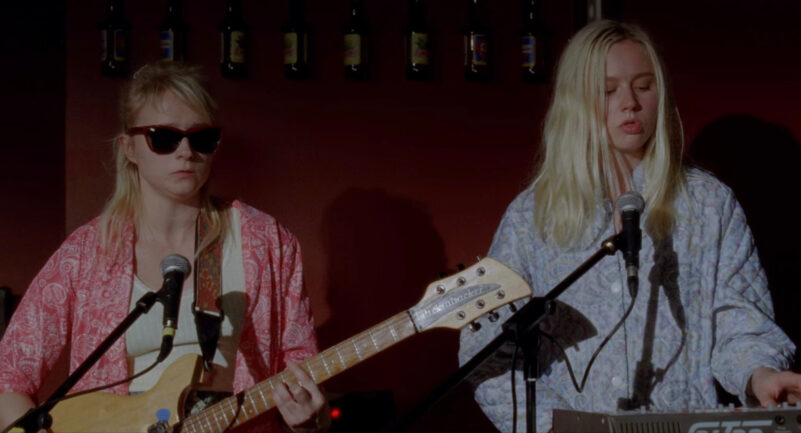
Throughout Fallen Leaves, music plays a crucial role, often directly commenting on the situation the characters are going through. Sometimes the music is purely soundtrack, meaning the songs were inserted by Kaurismäki as background music. But several times the music is diegetic, meaning the characters are hearing the music we hear. In these moments, the commentary nature of the songs gains a comical air, as the characters are actively reflecting on how a song speaks to their struggles. It’s a clever, almost sardonic move on Kaurismäki’s part that relates to the film’s exploration of how art plays a crucial role in reflecting on our lives.
But, nonetheless, by examining the content of the songs, we can gain perspective on what the characters are going through on a much deeper, psychological level. Let’s observe the most climactic use of song as an example: when the band Maustetytöt sings the song “Syntynyt suruun ja puettu pettymyksin” (which hilariously translates to “Born in sorrow and clothed in disappointment”) at the bar where Holappa decides to quit drinking.
Here are the lyrics translated to English, according to LyricsTranslate.com:
a moldy coffee in a pan
and dishes on the floor
rain is rinsing the windows
they don’t have to be washed by me
nothing is stopping me from leaving anymore
but I am casted in concrete up to my knees
on my back I have a burden weighing a ton
even though there is only a one checkpoint ahead of me
I don’t know if I manage all the way to grave
I am a prisoner here forever
fences surround the graveyard too
when finally my last worldly task would end
you still dig me deeper into the ground
I like you but can’t stand myself
I don’t need others, don’t know about you
I admit, if I leave
I only do it for the sake of myself
summer shoes and a hoodie too big
to the corner store in the cold
only a few beers again I get
if I need more
then I’ll have time to go again
because anyway I just mainly lie down
I don’t leave my house, without a reason at least
forget me, I want to be alone
I was born to sorrow and clothed with disappointments
I am a prisoner here forever
fences surround the graveyard too
when finally my last worldly task would end
you still dig me deeper into the ground
I like you but can’t stand myself
I don’t need others, don’t know about you
I admit, if I leave
I only do it for the sake of myself
I am a prisoner here forever
fences surround the graveyard too
when finally my last worldly task would end
you still dig me deeper into the ground
I like you but can’t stand myself
I don’t need others, don’t know about you
I admit, if I leave
I only do it for the sake of myself
The song opens with imagery of a moldy coffee and dishes on the floor, painting a picture of neglect and stagnation. The lyric “I am casted in concrete up to my knees” vividly captures Holappa’s sense of entrapment, reflecting his battle with alcoholism that leaves him feeling as though he’s stuck and can’t move on. This feeling of being rooted in place, unable to move forward, mirrors his stagnation in life.
The lyrics “even though there is only a one checkpoint ahead of me / I don’t know if I manage all the way to grave” speak to Holappa’s uncertainty about his ability to overcome his challenges and change his life’s trajectory. Holappa’s lyrics capture his struggle with the thought of change, especially as he confronts the formidable task of battling addiction.
The song also touches on themes of loneliness and self-imposed isolation. We see this in the lines “forget me, I want to be alone / I was born to sorrow and clothed with disappointments.” This shows Holappa’s tendency to withdraw into himself. It’s like a defense mechanism against the letdowns and sorrows he has faced.
The recurring lines “I am a prisoner here forever… I admit, if I leave / I only do it for the sake of myself” are particularly poignant. They point to realizing you’re stuck in a harmful pattern and seeing that any choice to improve has to come from you. This is a big moment for Holappa, showing he knows the way forward is up to him. At this juncture, Holappa comes to a crucial realization that he’s the one calling the shots on his journey to self-betterment.
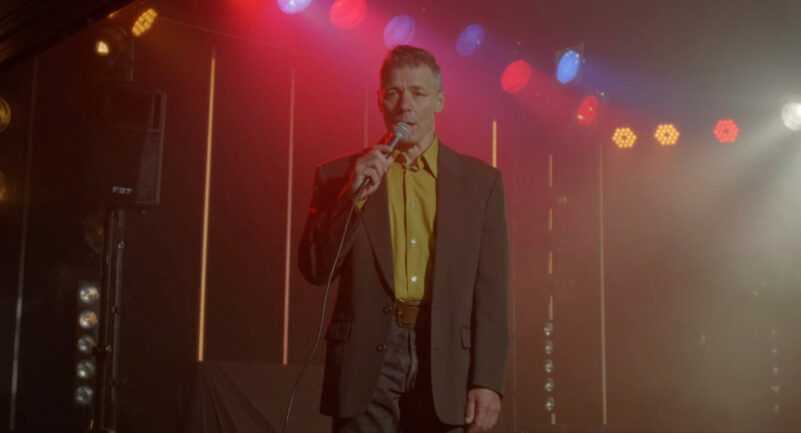
You could effectively do this sort of analysis with any song in the film. Particularly, Huotari’s rendition of “Syyspihlajan alla” (which translates to “Under the autumn rowan”) refers to the movie’s exploration of seasons (a theme that was briefly discussed in the ending explanation). Observe how everybody in the bar is captivated by the lyrics as he sings. Here are the words to that song:
Redden the berries with rowan, like there’s blood in them
The crane plows have flown already over my head
They didn’t take me with them those to distant lands
I can be satisfied without wings to the chains of the earth’s cold
Stay my sister, wind the night, it sings its songs
And rain with cold tears hit the dark window
I see many Miero travelers rushing by
I once waited for something he will never arrive
The hopeless nature of the song is contrasted by the hopeful nature of the film. Thus, the lyrics provide insight and reflection about the characters and what they’re going through during a specific moment, but do not define their lives and their ultimate catharsis and outlook. During autumn, the leaves die and fall from the trees, and the undeniably cold reality of winter is on the horizon—a constant rotation much like the cycle of war and destruction that plagues our planet. Huotari’s ballad at the karaoke bar highlights his relationship to this struggle, his ability to confront what is and find beauty in art’s ability to comment on universal truths.
Why is the movie called Fallen Leaves?
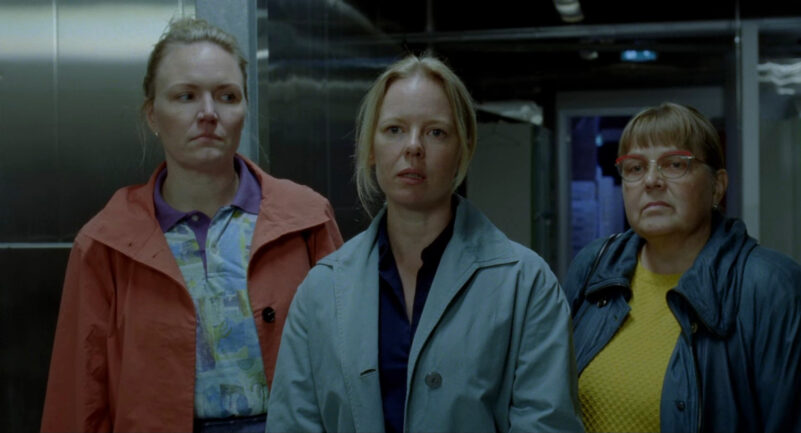
It’s been discussed a few times in this piece, including in the paragraph immediately preceding this section. But the short answer is that the title Fallen Leaves is a reference to the nature of seasons and the inevitability of fall and winter—periods when coldness and decay overwhelm society. Inevitably, this time of year can leave people feeling hopeless and lost, prisoner to a world where the crushing complexities of nature sadistically seem to align with humankind’s barbarous cycle of war and poverty. But the fallen leaves that scatter the ground as Ansa and Holappa walk away from the hospital to build a new life together give a strange sense of hope to the proceedings, serving as a sign that ever-lasting connections can be forged in the face of disrepair.
Questions & answers about Fallen Leaves
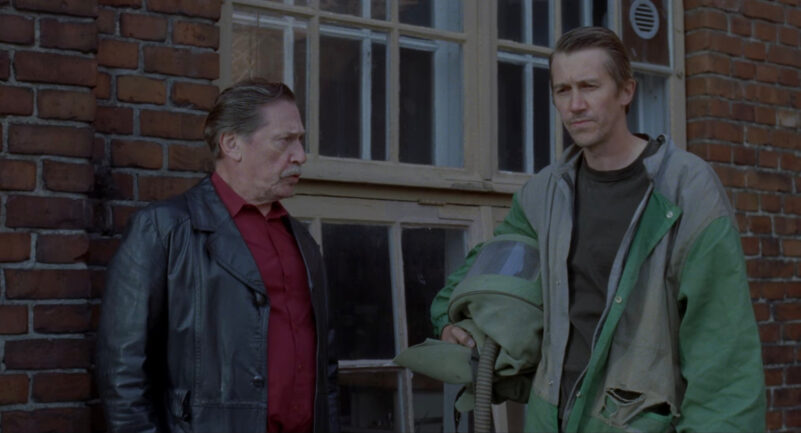
What movies are referenced in Fallen Leaves?
In total, as far as I can tell, Fallen Leaves references sixteen different movies. As discussed in the themes and meaning section, each reference adds context to the film’s thematic construction and aesthetic. Here’s every single reference, how it happens, and the potential thematic context of each instance:
- Brief Encounter (1945): The movie’s poster is displayed outside the movie theater, adding to the romantic and nostalgic ambiance of the film’s setting.
- Diary of a Country Priest (1951): This film is mentioned by a character, connecting the themes of introspection and moral struggle.
- Lost Continent (1951): Its poster is seen outside the movie theater, which serves as a commentary on the destructive nature of war.
- The Hole (1960): The Finnish poster for this film is shown, a movie about a man trying to escape prison, paralleling the Fallen Leaves characters societal imprisonment.
- Rocco and His Brothers (1960): A poster of this film appears in a bar, possibly reflecting on themes of family and struggle.
- The Hustler (1961): This film’s poster is also shown, perhaps nodding to themes of ambition and challenge.
- Contempt (1963): The movie poster is seen outside the theater, suggesting themes of relationship complexities.
- The Killers (1964): Its Finnish poster is displayed, evoking themes of fate and existentialism.
- Band of Outsiders (1964): Mentioned by a character, this reference might hint at themes of rebellion and adventure.
- The Face of Fu Manchu (1965): The appearance of this poster could be a nod to classic genre cinema.
- Pierrot le Fou (1965): The poster for this film, seen outside the theater, might suggest themes of escapism and existential crisis.
- The Red Circle (1970): Its Finnish poster is displayed, perhaps symbolizing themes of crime and morality.
- Fat City (1972): This poster could signify the struggles and hard-lived life reflected in the film.
- L’Argent (1983): Seen in the theater, this poster could symbolize the corrupting influence of money.
- Stranger Than Paradise (1984): The display of this poster might be a nod to the film’s exploration of the mundane and the oddity of everyday life.
- The Dead Don’t Die (2019): Holappa and Ansa watch this film at the cinema, directly engaging with a contemporary piece that reflects the film’s blend of deadpan humor and existential themes.

